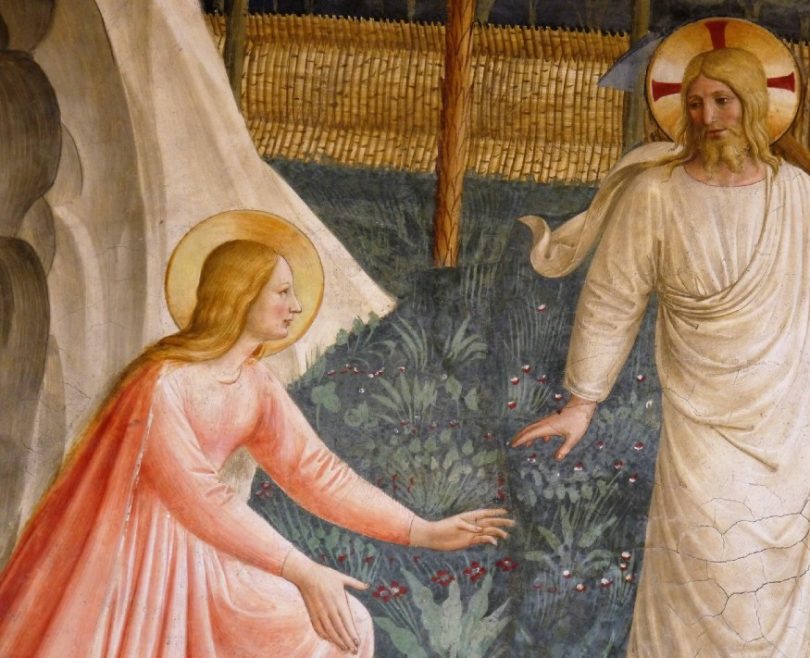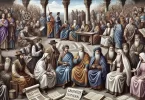According to the specific hermeneutics that I’ve applied to this particular biography, the most important woman in Christianity is not the so-called “Virgin Mary”, but rather Mary Magdalene. I say this because I firmly believe that Joseph was the father of Jesus, not God, although I do believe that Christ was a miracle worker, to some extent. Which is to say that, I think Jesus was a real historical figure, and that many of his followers were healed. Some were even brought back to life, and he then went on to raise himself from the dead. As such, the chief mourner in his flock, Saint Mary Magdalene discovered that the tomb was empty when she went in to anoint his remains Sunday morning. Then, she was chosen to be his first apostle, and in the decades and centuries that followed, these events began to be written down as the Holy Scriptures. As part of this literary legacy, Mary Magdalene’s story is clearly described in the Synoptic Gospels, in spite of the fact that she has been reduced to a minor character who is only mentioned a few times, unlike in the Gnostic Gospels which portray her as a central figure.
The thing is that, although it’s often included in translations of the Nag Hammadi library, the Gospel of Mary is not part of the “Chenoboskion Manuscripts”. The ancient text is not one of the Gnostic Gospels discovered near the Upper Egyptian town of Nag Hammadi in 1945. However, many of the things that are described in the Gospel of Mary are also discussed in the Gnostic Gospels. This is why these particular “Lost Gospels” are often lumped together by historians and theologians. Furthermore, the evidence indicates that the Gospel of Mary was written down by a Coptic Christian Neo-Platonist sometime in the late 2nd century. That particular forbidden book of the Bible was then buried in the year 367, unearthed in 1896, and published in 1955. More to the point, the ancient papyrus codex reveals what Mary was like as a person, far more than the New Testament does.
So, with that in mind, returning to the point I was making in the first paragraph, in the four pertinent canonical books of the Bible, Mary Magdalene is named as the key witness to the crucifixion of Jesus Christ. Furthermore, in both the Gnostic and Synoptic Gospels, she is present at his burial. That is to say, the Gospel of Matthew, the Gospel of Mark, the Gospel of Luke, and the Gospel of John all identify her, either alone or as a member of a larger group of women which includes Jesus’s mother and aunt, as the first to witness the empty tomb. The point is that in every version of herstory, Saint Mary Magdalene was the very first person to find the Risen Jesus and testify about his return. Furthermore, according to the Gospel of John, Mary mistook Jesus for a gardener, only to realize that he was a god, or rather the God, as many have come to believe. So, she wasn’t just in the right place at the right time. He was waiting for her to find him, and this turned a minor sect into a major religion.
As part of that, it’s important for people to understand that Mary Magdalene is always one of the “Three Marys” that appear in religious paintings, such as “The Three Marys at the Tomb” from the 15th century. Religious iconography is rife with these all-important sets of Marys. Thus, there were “Three Marys” present at the crucifixion on Good Friday, and then again, but not all the same ones at the tomb after the resurrection on Easter Sunday. I mention this because there are a lot of women named Mary in the Bible, so things can get rather confusing in no time at all. For instance, there was the harlot, Mary of Egypt, and then there was the saintly Mary Salome. There was Mary of Bethany the sister of Lazarus, as well. She became the disciple Martha since there was already a Mary in Jesus’ congregation. The point is that about a quarter of the female population living under Herod’s rule was named after his wife, Mariamne. More to the point, Jesus knew a lot of Marys, including his mother, his sister, his aunt, and, especially his most faithful follower, Mary Magdalene.
Moreover, the Gospel of Luke reveals where Mary’s all-important steadfast devotion came from. When Jesus first met Mary she had schizophrenia, which is to say, she was possessed by a legion of demons. More importantly, after Christ exorcised the evil spirits, Mary became a true believer in his preachings. The Aramaic incantations that he had uttered banished the voices in her head, and for that, she remained forever grateful to him. Jesus soon took to calling her the “Tower”, the same way that he called Peter the “Rock”. In Mary’s eyes, Jesus could do no wrong. This profoundly transformed her life and the world around her. She came to believe that Jesus was the prophesied messiah who would save the virtuous monotheistic Jews from the vicious polytheistic Romans, once and for all. So, even when the other disciples were in hiding, she didn’t waver in her commitment to Christ. Mary Magdalene stood by him on Golgatha risking the wrath of Rome. She was absolutely fearless in the face of her oppressors, a female warrior through and through.
However, this was all the more reason for the more misogynistic male disciples, like Peter and Paul, to be jealous of her. To make matters worse, their deeply-rooted aversion to powerful women worked its way into the telling of many of the stories in the New Testament. To make matters worse, an inaccurate portrayal of Mary Magdalene as a prostitute began after a series of Easter sermons given in the year 591, by Pope Gregory I. He conflated Mary Magdalene, who is introduced in Luke 8:2, with Mary of Bethany in Luke 10:39, and the unnamed “sinful woman” who anoints the feet of Christ in Luke 7:36. In reality, these were three separate women. So, finally, after more than a millennium of misinformation, in 1969, the identification of Mary Magdalene with Mary of Bethany and the unnamed “sinful woman” was removed by Pope Paul VI. Granted, the view of her as a former prostitute still persists to this very day, nonetheless. Although, Pope Francis did recently reaffirm the truth about her in the 21st century, as well. He took the biggest step yet to rehabilitate Mary Magdalene’s image by declaring a major feast day celebrated every year on June 22nd in her honor.
Not to get too much into a feminist scholar rant, the point is that there were more than just twelve apostles of Christ, including a number of women, such as Mary Magdalene. Plus, in many ways, the female disciples were more significant than the male disciples. For instance, the apostle Joanna aided Christ and his followers financially during his ministries. She and some of the other women disciples supported them in their travels, otherwise, those who had been healed could not evangelize as their healer had instructed. On top of that, Mary Magdalene took the leading role among the women from Galilee. As part of this, in the early days of Christianity, both men and women could be part of the clergy, including cardinals and bishops. So, there was originally an egalitarian inclusion of Christian women in ordination. It wasn’t until the 4th century that the religion was masculinized by Constantine, making the clergy lopsided. Since then, the chauvinist conspiracy of the heteronormative patriarchy has completely overtaken the Catholic Church.
As if that wasn’t bad enough, in modern Christianity, a number of medieval legends from western Europe began to tell exaggerated tales of Mary Magdalene’s wealth and beauty, as well as her alleged missionary journey to southern France. This alternate “history” was then capitalized on and popularized by Dan Brown in The Da Vinci Code. However, the reality is that Jesus and Mary were in spiritual communion, not carnal union, with one another. Therefore, the legend that a bloodline lives on is nothing more than speculative fiction based on fanciful French folklore. In reality, Jesus Christ and Mary Magdalene were not lovers, but they did love each other deeply. Then, again, he did kiss her more often than the other disciples, according to the Gospel of Philip. However, it’s crucial to understand that this was something he did whenever one of the members of the inner circle understood his teachings. That is to say, the kisses on the forehead were symbolic of an exchange of gnosis, which is personal, direct, immediate, higher knowledge. It just meant that Mary understood Jesus’ teachings in a different way than all the other disciples. On top of that, Jesus and Mary were both chaste, having “renounced the passions” that Christ spoke out against as a preacher. Therefore, it’s inconceivable that she would have conceived.
In the end, Mary Magdalene was a pious prophetess and priestess, not a pregnant prostitute. According to the Gospel of Mary, she was Jesus’ favorite student and the sole recipient of his most important teachings about how to overcome ignorance and “achieve the ascension of the soul”. This esoteric knowledge was quite different from what became the standard doctrines of the Church. This made Pope Peter so resentful of Mary that it set the stage for the split between the Gnostics and Catholics. It was the Tower versus the Rock, in an epic world-changing battle, the outcome of which has left billions of Christians reeling for millennia. To make matters worse, as a consequence of her bad reputation, the first messenger of the good news of the resurrection is thought of in negative ways to this very day. To me, this seems completely idiotic because, when you really think about it, like the impact that Cleopatra had on the world, Mary Magdalene was one of the most pivotal women in the whole of human history. That’s why we can’t let her just be reduced to mere footnotes. The way I see it, Saint Mary Magdalene more than deserves to be in the spotlight, shining as an exemplar for generations on end.







